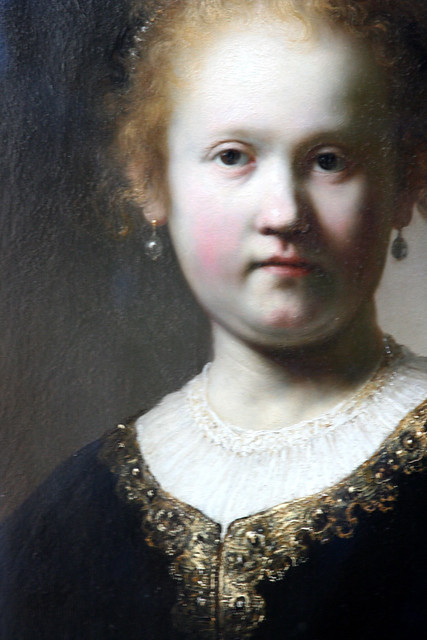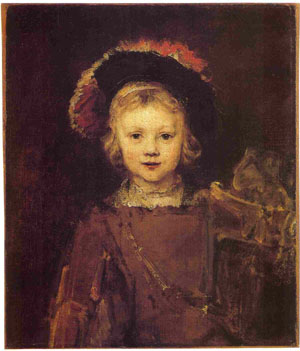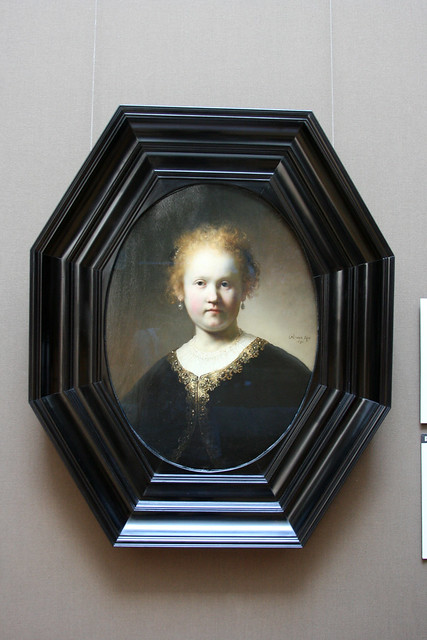 |
| Girl Wearing Gold-Trimmed Cloak (detail), 1632 Rembrandt van Rijn, (Dutch 1606-1669) |
Last fall, my son and I went on a Southern California college tour. On our way from San Diego to Santa Barbara, we had time to visit The J. Paul Getty Museum in Los Angeles. A lobby sign announced that there was a portrait by Rembrandt van Rijn on exhibit. I was unfamiliar with this portrait and looked forward to seeing her.
When I was in the presence of this young girl, she took my breath away. My response reminded me of the time I was face to face with Rembrandt's portrait of his son Titus.
 |
| Portrait of a Boy in Fancy Dress aka Titus, 1655 Rembrandt van Rijn, (Dutch 1606-1669) |
I marvel at Rembrandt's ability to capture the tenderness in the eyes of his subjects. Though his painting style evolved in the intervening twenty or so years, these portraits convey the trust his sitters have in him as he portrays not just their image, but also their spirit.
The young female in Girl Wearing Gold-Trimmed Cloak is believed by some to be Rembrandt's sister. It would explain the trust in her eyes and her frequent appearances in his paintings. One of Getty's prized paintings is Abduction of Europa, painted by Rembrandt in the same year.
 |
| The Abduction of Europa, 1632 Rembrandt van Rijn, (Dutch 1606-1669) J. P. Getty Museum (61 x 78 cm) |
It was a privilege to see the young girl's portrait hanging side by side with the masterpiece portraying her as Europa being abducted by Jupiter as a bull.
 |
| The Abduction of Europa (detail), 1632 Rembrandt van Rijn, (Dutch 1606-1669) J. P. Getty Museum (61 x 78 cm) |
Rembrandt used Ovid's telling of the myth as his inspiration:
“He moved among the cows, more beautiful than they or other bulls,Centuries later, in 1975, the young girl was abducted once again. This time in Boston at the Museum of Fine Arts, when two men stole Girl Wearing Gold-Trimmed Cloak at gunpoint. The following year, she was dramatically returned by a man in a ski mask. Law enforcement officials found her, wrapped in an old brown quilt, after they surrendered the keys to the trunk of their car to the masked man.
he strolled spring grasses, white as the snow untouched
by southern rains or footprint on the ground,
huge, silky muscles at his neck and silvered dewlaps hanging,
horns as white as if a sculptor’s hand had cut them out of pearl.
And no one feared his look, forehead and eye were gracefully benign…
Agenor’s daughter gazed at him in wonder.”
(Ovid, Metamorphoses II.849-59)
The painting was back on exhibit in Boston for another decade. In 1986, the owner, Robert Treat Paine II, decided to auction off the portrait before new capital gains tax laws would come into effect the following year. He bought the painting in 1929 for $125,000 from Prince Johannes II of Lichtenstein. I shudder to think what the tax bill would have been since the masterpiece brought the record price of $10.3 million. An anonymous New York collector has generously loaned the painting to the Getty Institute for an extended period of time.
Please visit Lisa at Lisa's Chaos for more Macro Monday images.
_________
"Philolog: Rembrandt and Ovid: The Abduction of Europa, 1632; Metamorphoses II.849-59 and the Myth Tradition." Metamedia at Stanford. Web. 02 May 2011.
Kennedy, Randy. "Portrait of a Girl Wearing a Gold-Trimmed Cloak - J. Paul Getty Museum - Art - New York Times." The New York Times - Breaking News, World News & Multimedia. 02 May 2011. Web. 02 May 2011.

